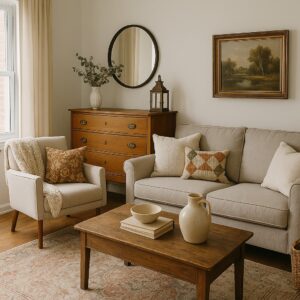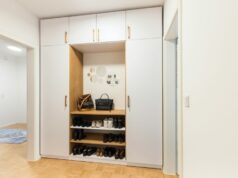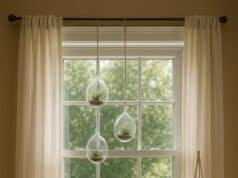Table of Contents
- Why Vintage Appeal Still Captivates Today
- Blending Old and New: Achieving Balance
- Key Elements That Define Vintage Style
- Steps to Achieve a Vintage-Modern Interior Design
- Creative Ways to Source Vintage Pieces
- Budget-Friendly Tips for Vintage Decor
- Maintenance and Care of Vintage Items
- Making Vintage Decor Work in Small Spaces
Why Vintage Appeal Still Captivates Today
Walking into a room with vintage-inspired decor transports you through time and tells stories that mass-produced furniture cannot replicate. The attraction towards authentic designs stems from people who want genuine elements alongside warm and historical characteristics. The modern housing trend of using vintage items transforms ordinary houses into personal residences through their ability to add depth and character. People choose vintage-inspired design for more than aesthetic purposes since it represents a response to the current sustainability movement. The growing environmental consciousness drives people toward sustainable practices, including repurposing old items to create unique home decor that matches current design trends.

People who want to introduce retro elements into their space or merge vintage with contemporary styles can easily find affordable, character-rich decor. The streamlined search process made possible by online marketplaces and curated collections enables new and experienced decorators to discover budget-friendly treasures. The fast-paced decorator can find vintage-inspired furniture and decorative items and shop decor on sale at Decor Steals. The current homebuyer preference for unique elements explains why vintage decor requests remain one of the most popular interior design choices.
The House Beautiful trend analysis shows vintage decor has become increasingly popular according to online search data and social media hashtag activity during recent years. The increasing popularity indicates a widespread longing for meaningful customized environments. Vintage-inspired interiors serve as a strong tool for self-expression and develop enduring comfort beyond current design trends.
Blending Old and New: Achieving Balance
Achieving harmony between historical elements and modern needs demands attention to detail. Your goal should be to select specific antique pieces that share stories while meeting your daily requirements instead of collecting random antiques. The combination of retro wooden chests with modern chairs generates visual interest and starts discussions without overwhelming the space. Mixing items from different periods helps maintain a dynamic atmosphere which prevents the rigidness that some single-style decorations create.
Designers suggest combining vintage textiles with modern light fixtures and placing mid-century ceramics on contemporary shelving units to create visual interest. The strategic approach enables you to appreciate all individual characteristics of each object. The New York Times presents an article that demonstrates how pairing precious family heirlooms with contemporary acquisitions allows people to appreciate historical elements alongside modern freshness. The key to successful integration lies in developing connections through color or material or purpose which lets each piece stand out within a harmonious space.
Combining antique and contemporary furniture creates depth in rooms by offering comfort through morning coffee at wooden tables and sleek Scandinavian chairs. Thoughtful curation stops rooms from becoming “theme rooms,” which feel staged instead of lived-in. The goal is to develop personal expression by building spaces that show intention rather than randomness.
Key Elements That Define Vintage Style
The visual signs and materials that define vintage-inspired decor include. Recognizing these visual cues makes it simpler to incorporate nostalgic elements even when using only a few nostalgic items. The foundation of vintage style decor begins with decorative hardware that includes items such as patinated brass handles and glass knobs and weathered iron brackets. Basic furniture can be transformed into distinctive features through these understated details.
Patterned textiles including floral, gingham, damask, or lace fabrics serve to enhance the historical feel when used for curtains and pillows as well as upholstery. Shelving units or accent walls incorporate elements including barn wood and painted tin and galvanized metal which express their previous use and age.
The combination of vintage-inspired elements such as lanterns and old mirrors and milk glass and enamel jugs creates an instant retro atmosphere while also providing functional purposes and sparking conversations.
The handcrafted nature of pottery and woven baskets and stitched linens produces artisanal craftsmanship that factory-produced goods typically cannot match.
A combination of three essential elements in your home creates a welcoming atmosphere through historical elements and textured components.
Steps to Achieve a Vintage-Modern Interior Design
A deliberate plan helps you combine vintage elements with modern aesthetics although the process becomes simpler when you have a design concept. Your space requires a neutral color scheme for major elements which should include beige walls and soft gray sofas and natural wood floors.
These “blanks” enable easy vintage accessory swaps while allowing new ideas testing without creating visual clutter.
- The stage must be set with neutral colors that dominate the largest surfaces to create a balanced environment which showcases unique discoveries.
- Select your favorite vintage item to establish a color scheme. The essential colors you extract from your favorite artwork, vase or rug should be repeated discreetly throughout the space.
- Focus on statement pieces. A single prominent antique lamp or an antique farmhouse bench should anchor your interior design instead of filling the room with numerous small objects.
- Textiles together with art pieces help create layered visual effects. The addition of vintage quilts or classic prints along with throw pillow changes allows you to introduce variety while maintaining low expenses.
- Edit regularly. To maintain an uncluttered space you should periodically switch your objects throughout the year while presenting only items that match the present emotional state or seasonal theme.
The designed approach establishes an aesthetic path while encouraging individual design approaches to produce meaningful rather than accidental spaces.
Creative Ways to Source Vintage Pieces
The thrill of vintage treasure hunting originates from unpredictable discoveries which can appear in unexpected places. The classic flea market offers a wide selection of sturdy farm tables alongside delicate glassware items. Estate sales together with auctions provide valuable opportunities to acquire high-quality items particularly when you seek items with historical value.
Regular visits to local consignment shops and charity stores will yield new decorating opportunities with unique items at affordable prices. Online communities together with neighborhood exchange groups offer potential deals while connecting you to the local design community. The most meaningful possessions often arrive from family and friends since these items possess authentic sentimental value which cannot be replaced by commercial purchases. The rewarding hobby of antique hunting requires both patience and attention to find the best opportunities.
Budget-Friendly Tips for Vintage Decor
Vintage-style decor for your home can be achieved without emptying your bank account. Creative decorators implement several modern approaches to maximize their budget while achieving maximum style results. First step: Visit secondhand stores and marketplaces with consistent frequency. Regular visits to stores will yield fast-moving inventory while continuous searching leads to unexpected discoveries.
- Be strategic with spending. Use your money to acquire distinctive items such as unique mirrors or colorful vintage lamps while finishing your decor with less expensive decorative elements.
- Embrace DIY. The transformation of everyday objects occurs through painting and distressing techniques as well as basic hardware exchanges. A few creative ideas allow modern end tables to acquire vintage characteristics.
- Mix old and new. The combination of authentic vintage pieces with affordable reproductions extends your budget while creating an eclectic atmosphere.
- Upcycle and repurpose. Wooden crates convert into storage shelves while old suitcases transform into unusual end tables and storage containers.
- Rotate seasonal decor. The approach to seasonal updates involves changing vintage prints and table linens and ceramic items rather than purchasing new decorative items for each trend.
Budget-friendly decorating requires the fundamental element of experimental willingness because rooms develop their best appearance through time-based accumulation of individual pieces.
Maintenance and Care of Vintage Items
Vintage decor needs extra maintenance work than commercial products do. The extra maintenance work delivers long-term benefits of durability and aesthetics because wooden furniture needs regular dusting with a soft cloth to stop dust accumulation. The cleaning of old ceramics with mild soap and water should be done with care since brass and iron require occasional non-abrasive polishing to stop tarnishing.
Regular maintenance work should be performed on your treasured possessions right now. Protect antique pieces from sunlight exposure which leads to fading and conduct regular checks for textile damage from humidity and pest infestations. The use of natural oil or beeswax finish on wood protects it from drying out and cracking. Special items that show signs of wear should receive professional restoration or repair services to ensure their preservation for future generations. Vintage decor develops its own personality through regular maintenance rather than deteriorating.
Making Vintage Decor Work in Small Spaces
Every size of apartment or condo space can successfully display vintage aesthetic elements. The solution for creating vintage charm in small spaces depends on choosing multi-functional items that combine storage functions with furniture uses such as storage trunks for coffee tables or ladder-blanket racks or vintage tins as wall shelves. Such multifunctional decor both optimizes space usage and adds distinctive character elements while keeping the area uncluttered.
Mirrors positioned in strategic areas create an illusion of expanded space while showcasing traditional textiles and artwork patterns. Small antique items including books and glass containers and botanical prints add personalized touches to any room space. The smallest homes need only one distinctive piece to develop a comfortable inviting corner that receives praise because of its creative design.








